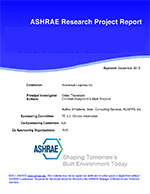Description
Part 1 of this report describes experimental research aimed at evaluating the seismic performance of an isolation/restraint system, typical of the systems designed by ASHRAE members, supporting heavy mechanical equipment. The ASHRAE-type isolation/restraint system consisted of coil springs and rubber snubbers constraining the displacement in the horizontal and vertical direction. The heavy HVACtype mechanical equipment used as test specimen was a centrifugal liquid chiller. Systemidentification and seismic shake table tests were conducted on the test specimen mounted on four of the isolation/restraint systems. The test plan included variation of design parameters of the restraint component of the systems, such as gap size, rubber pad thickness and hardness, and static capacity. The tri-axial acceleration response at the center of mass and corners of the chiller, displacement response of the chiller, and the dynamic forces induced into the isolation/restraint systems were recorded in each test. The experimental results were analyzed to determine the response amplification due to the engagement of the restraint components, to investigate the sensitivity of the seismic performance of the isolation/restraint systems to the variations of their restraint component design parameters, and to compare the static design capacity of the restraint components to their dynamic (actual) capacity.
Part 2 of the experimental study described in this report is aimed at evaluating the seismic-performance of Isolation/Restraint (I/R) systems for light mechanical equipment. Earthquake-simulator experiments were conducted on an air-handling unit in two different conditions: supported by six I/R systems and rigidly mounted. The test plan included seismic and system-identification tests, and incorporated different input motion amplitudes and different I/R system properties. The test results showed that limiting the displacement of the equipment by the restraint components of the I/R systems resulted in amplification of the equipment acceleration-responses. Dynamic forces induced into the I/R systems were considerably larger than the forces predicted by the static approach. Based on the test results, reducing the gap size is the first recommendation to improve the seismic-performance of I/R systems in areas of high seismicity. Increasing the thickness of rubber snubbers is a solution to reduce the dynamic forces induced into the I/R systems, however it might result in higher acceleration and displacement responses of the equipment. Reducing hardness of rubber snubbers is not recommended as it can degrade the overall seismic performance of the I/R systems. The test results showed that higher amplification of acceleration responses should be expected for light and flexible equipment than for rugged and heavy equipment.
Product Details
- Published:
- 2008
- Number of Pages:
- 190
- File Size:
- 1 file , 10 MB
- Product Code(s):
- D-RP-1323




